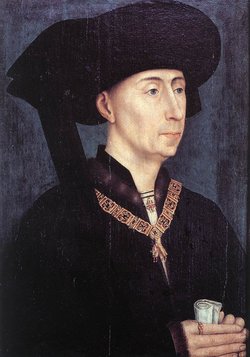Philip the Good
|
|
Philip III, Duke of Burgundy (Philip the Good or Philippe le Bon) (July 31, 1396 – June 15, 1467) was Duke of Burgundy from 1419 until his death. He was a member of the Valois family (the Royal family of France).

Born in Dijon, he was son of John the Fearless and Margaret of Bavaria. He became duke when his father was assassinated in 1419. Philip accused Charles, the Dauphin of France of planning the murder of his father, which took place during a meeting between the two at Montereau, and in 1420 Philip allied himself with Henry V of England under the Treaty of Troyes. In 1423 the alliance was strengthened by the marriage of his sister Anne to John, Duke of Bedford, regent for Henry VI of England. In 1430 Philip's troops captured Joan of Arc at Compiegne and handed her over to the English, who orchestrated a heresy trial against her. The alliance with England was broken in 1435 when Philip attacked Calais and, under the terms of the Treaty of Arras, recognized Charles VII as king of France. This alliance was broken in 1439, and in 1440 he supported the revolt of the French nobles (an event known as "the Praguerie") and sheltered the Dauphin Louis.
Philip preferred to expand his own territory rather than become directly involved in the Hundred Years' War. He incorporated into Burgundian territory Namur in 1421 (by purchase from John III, Marquis of Namur), Hainault and Holland in 1432 (with the defeat of Countess Jacqueline in the last episode of the Hook and Cod wars), Brabant in 1430, and Luxembourg in 1443.
Philip was considered an extravagant ruler who embodied the qualities of chivalry. He declined membership in the English Order of the Garter in 1422, but created his own order in 1430, the Order of the Golden Fleece, supposedly based on the Knights of the Round Table. He had no fixed capital and set up court in various places, usually Brussels, Bruges, or Lille. He held grand feasts to show off his power to his subjects, and the knights of his Order frequently travelled through his territory participating in tournaments. In 1454 he also planned a crusade against the Ottoman Empire, but this plan never materialized.
He was also a patron of the arts, commissioning many tapestries and other works of art. In 1428 Jan van Eyck travelled to Portugal to paint King John I's daughter Isabella before Philip married her. With help from more experienced Portuguese shipbuilders Philip established a shipyard in Bruges. Roger van der Weyden painted his portrait (illustration, above left) wearing the collar of the Order of the Golden Fleece..
In 1463 Philip returned some of his territory to Louis XI. That year he also created an Estates-General on the French model. Philip died in Bruges in 1467 and was succeeded by his son Charles the Bold.
See also
External Links
- Brief Profile (http://dijoon.free.fr/bestof/philgood.htm) - Contains a short biography of Philip.
- EHistory page (http://www.ehistory.com/middleages/PeopleView.cfm?PID=311) - Short sketch of the Duke's life.
- Joan of Arc's First Letter to Philip (http://archive.joan-of-arc.org/joanofarc_letter_June_1429.html) - Mention of a letter dictated by Joan of Arc to Duke Philip in June of 1429.
- Joan of Arc's Second Letter to Philip (http://archive.joan-of-arc.org/joanofarc_letter_july_17_1429.html) - Translation of a letter dictated by Joan of Arc to Duke Philip on 17 July 1429.
